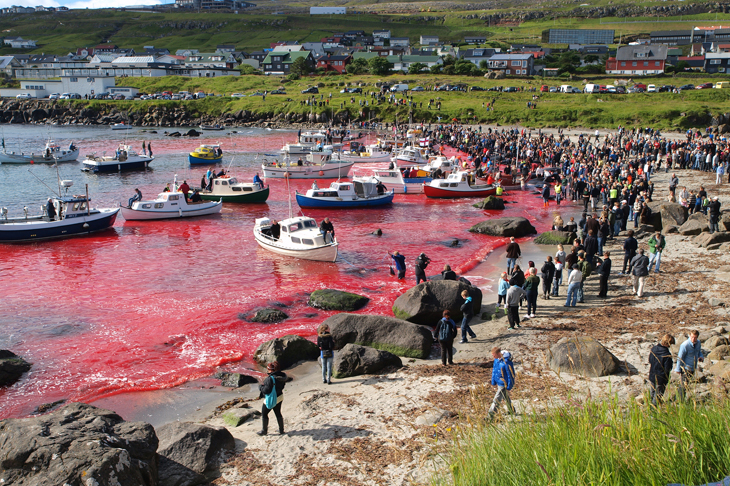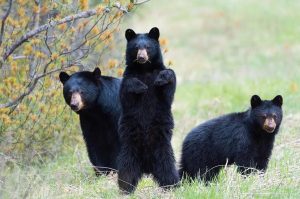Nick Pyenson, curator of fossil marine mammals at the Smithsonian Institute in Washington, is quick to tell us he’s not a ‘whale hugger’. ‘I didn’t fall asleep snuggling stuffed whales or decorate my room with posters of humpbacks suspended in prismatic light.’ Pyenson sees whales through their ancestral bones, and their contemporary entrails, digging up their past or scrying their future. Spying on Whales begins its surveillance in the fossil-rich site of Cerro Ballena (‘Whale Hill’) in the Atacama desert. Here, in the Miocene layers, he uncovers an entire pod of ancient, stranded whales, stilled in the moment of their deep-time death. It’s an Indiana Jones moment. He may disavow cetacean sentimentality in favour of scientific rigour, but Pyenson can’t resist enlivening his exploits with a boyish excitement.
And it is an exciting world, this one of prehistoric whales: 600 extinct species —compared to the current 85 extant ones — which include the wondrous ‘walrus whale’, a mash-up of the Arctic tuskers with dolphin-like bodies; and the ferocious ‘killer sperm whale’, arrayed with canines in both upper and lower jaws. In Pyenson’s evocative phrase, the Miocene is
a kind of fever dream of the present, drawing on familiar members of today’s ecosystems, in similar settings, but with occasional aberrant and nightmarish forms.
But it’s when Pyenson turns to our era that things become really interesting. Drawing on his whale evolution work, he notes that modern whales are even more monstrous than their forebears, reaching 100 feet or more in the case of the blue whale, an animal whose size may only be restricted by the size of its mouth and the attendant drag factor on its yawning jaws.
Could whales get any bigger, he asks? His answer comes in the slaughter of the last century, when the whaling fleets of Norway, the Soviet Union, Japan and Britain, mostly working in the Southern Ocean, killed the largest whales, thereby destroying the genetic strength of populations and the actual size of subsequent individuals.
Ironically, much of our recent knowledge about whale physiology, long-evity and distribution was gathered by the British Discovery expedition based in the South Atlantic. It was information gained at the expense of thousands of whale lives, and collected by ‘hip-booted scientists’ (in the Princeton historian D. Graham Burnett’s phrase) who’d bribe whalers with bottles of whisky in return for aborted whale foetuses.
Pyenson looks back to his predecessor at the Smithsonian, Remington Kellogg, a dour man who, despite negotiating the first laws to protect the North Atlantic right whale in 1937, made inadequate efforts to discipline the nascent International Whaling Commission, leaving it to become a global whale-hunting club as a result. According to a 2015 paper by Robert Rocha of the New Bedford Whaling Museum, Massachusetts, three million great whales were taken out of the oceans in the 20th century. Pyenson notes solemnly that ‘the consequences of this scarcity are still poorly understood’, and rightly points out that the removal of that biomass has accelerated climate change by diminishing the fertilising effect of whale faeces on carbon-sequestering plankton. (But Pyenson’s odd description of whale poo as ‘fleecy’ mystifies me. Having often swum at the back end of a whale, I can attest to it having the consistency of a runny red cloud.)
Whaling is not ancient history. There was uproar recently when it was reported that a blue-fin whale hybrid had been killed by the Icelandic whaling operator, Hvalfur hf. As a result of Japan’s 2018 whaling season — a ‘field survey’, according to their government — 122 pregnant minke whales have been killed. Reading the recent past into his present, Pyenson asks himself: ‘What would I have done in [Kellogg’s] shoes? Was there anything to change about the fate of whales on Earth had I been in his place, at his time?’ His answer comes when he describes his own research work carried out in Iceland in 2009 and 2010 on a whaling ship owned by Hvalfur.
With access to freshly-slaughtered whales, Pyenson was able to discover a hitherto unknown sense organ at the tip of a fin whale’s jaw, used to detect its prey. It was an extraordinary revelation — but at what cost? How do Pyenson’s actions differ from Japanese whalers who claim to kill whales for scientific investigation? The spying of Pyenson’s title starts to take on a dark undertone. There’s no movie-style disclaimer here — ‘No whales were harmed in the making of this book’ — because they were. In a paper published in 2015, Pyenson specifically thanks Kristjan Loftsson, the controversial director of Hvalfur, which has killed 769 fin whales since 2006 (including 63 animals this year to date) and exported thousands of tonnes of whalemeat to Japan. (Statistics supplied by Whale and Dolphin Conservation.)
Pyenson reasons that Hvalfur’s self-declared annual quota of 125 fin whales would have little effect on a North Atlantic population of 50,000: ‘As many fin whales are likely to be killed every year by net entanglement and ship strikes.’ The whales he sampled would have been killed anyway; he was just making good scientific use of them. ‘Once stripped of their meat, the carcass remains were not valuable to the whalers but could be a gold mine for us.’ But why not wait for a stranded fin whale — they are not rare — on which to conduct such experiments?
Some would contest that Pyenson’s work lends credibility to a commercial operation that defies world opinion by killing endangered, sentient animals that can take up to three hours to die. No landbound abattoir would allow such cruelty. And as Pyenson himself notes later, baleen whales may possess the same intelligence as primates, our nearest animal relatives. I’m afraid I’m with the whale-huggers on this one.
Pyenson wrestles with scientific objectivity and his own conscience as he looks to the future. The melting Arctic spells uncertainty for the giant bowhead whale, an animal which may live for up to 300 years. The vaquita, a small porpoise in the warm waters off Mexico, is about to become extinct; even as its rescuers try to save the handful of animals that are left, they die of fear as they are lifted from the water. What we observe, we destroy.
Pyenson’s highly readable book is an excellent exemplar of popular science; but when he walks into that vast hangar that houses the Smithsonian’s renowned collection of bones of extinct and soon-to-be extinct animals, he might take heed, not of Remington Kellogg, but of Ishmael, the unreliable narrator of Moby-Dick who, after 135 chapters of exasperating detail, finally declares of the whale: ‘I know him not, and never will.’


















